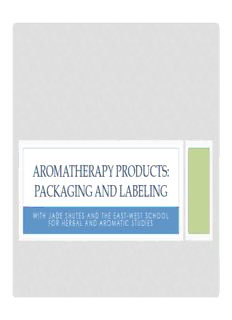
Aromatherapy Products PDF
Preview Aromatherapy Products
AROMATHERAPY PRODUCTS: PACKAGING AND LABELING WIT H J ADE SHUTES AND THE EAST-WE ST SCHOOL FOR HERBAL AND AROMATIC STUDIES THE GOAL IS NOT TO STRESS YOU OUT! THE GOAL • Is to share information so that you are better able to create, produce, label and market your aromatherapy products, effectively, safely, and in accordance with the laws governing cosmetics. • My personal goal is to ease your mind and to provide you with resources to support you and your business. HOWEVER, YOU MAY WANT TO MEDITATE OR TAKE AN AROMATIC BATH AFTER THIS WEBINAR! DEFINING COSMETICS United States Canada Europe UNITED STATES: FDA DEFINITION OF “COSMETICS” • Is It a Cosmetic, a Drug, or Both? (Or Is It Soap?) • The Federal Food, Drug and Cosmetic Act (FD&C Act) defines cosmetics by their intended use, as “articles intended to be rubbed, poured, sprinkled, or sprayed on, introduced into, or otherwise applied to the human body…..for cleansing, beautifying, promoting attractiveness, or altering the appearance” (FD&C Act, sec. 201 (i). • Products include: • Skin moisturizers • Perfumes • Lipsticks, fingernail polishes, eye and facial makeup preparations • Cleansing shampoos • Hair products: permanent waves, hair colors • Deodorants • As well as any substance intended for use as a component of a cosmetic product. FDA - AROMATHERAPY • An Aromatherapy product is categorized according to its intended use. • Cosmetic: see definition on previous slide. • Drug: The FD&C Act defines drugs, in part, by their intended use, as "articles intended for use in the diagnosis, cure, mitigation, treatment, or prevention of disease" and "articles (other than food) intended to affect the structure or any function of the body of man or other animals" [FD&C Act, sec. 201(g)(1)]. HOW IS A PRODUCT'S INTENDED USE ESTABLISHED? • Claims stated on the product labeling, in advertising, on the Internet, or in other promotional materials. Certain claims may cause a product to be considered a drug, even if the product is marketed as if it were a cosmetic. Such claims establish the product as a drug because the intended use is to treat or prevent disease or otherwise affect the structure or functions of the human body. Some examples are claims that products will restore hair growth, reduce cellulite, treat varicose veins, increase or decrease the production of melanin (pigment) in the skin, or regenerate cells. HOW IS A PRODUCT'S INTENDED USE ESTABLISHED? • Consumer perception, which may be established through the product's reputation. This means asking why the consumer is buying it and what the consumer expects it to do. • Ingredients that cause a product to be considered a drug because they have a well-known (to the public and industry) therapeutic use. An example is fluoride in toothpaste. • ***Social Media: Twitter, Facebook etc. REGULATIONS FOR SOAP • Soap is a category that needs special explanation. That's because the regulatory definition of "soap" is different from the way in which people commonly use the word. Products that meet the definition of "soap" are exempt from the provisions of the FD&C Act because—even though Section 201(i)(1) of the act includes "articles...for cleansing" in the definition of a cosmetic—Section 201(i)(2) excludes soap from the definition of a cosmetic.
Description: